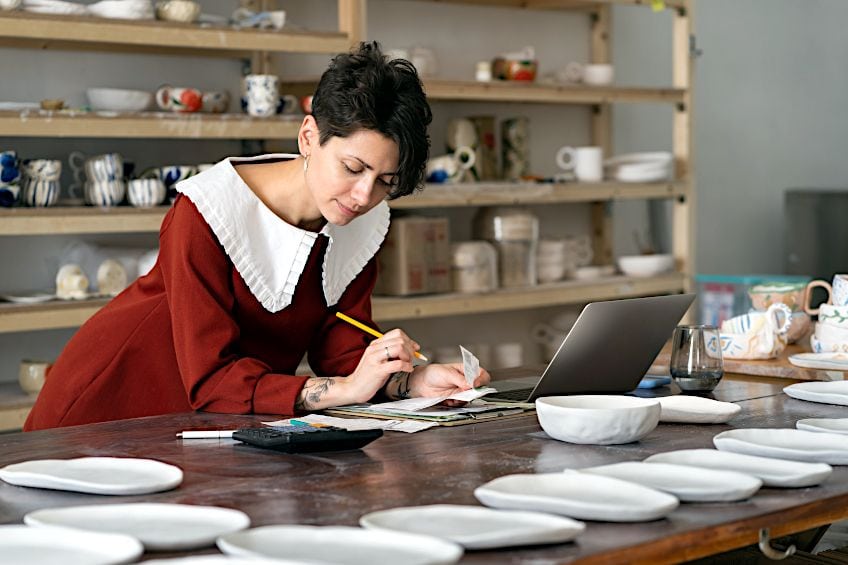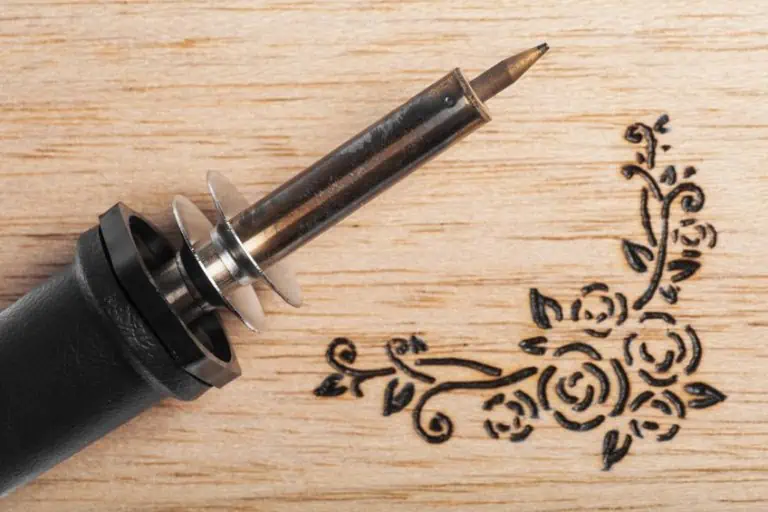How to Price Your Art – Our Easy-to-Follow Art Pricing Guide
This post may contain affiliate links. We may earn a small commission from purchases made through them, at no additional cost to you.
When deciding on how to price your art, whether you are new to the scene or have been selling your art for a while, pricing can be a bit of a challenge. If you go for a price that is too low, you are selling yourself short, or if you set the price too high, making sales could be a problem. To help you along the way, here is our art pricing guide.
Table of Contents
A Guide to Pricing Your Art
Being creative, designing, and making amazing art pieces is the focus of what an artist does. However, to make art sales, there is so much more that comes into play for this to happen. Once your art is made, you can then sell your art yourself online, through a gallery, going to art fairs, or opening your own studio, amongst other ideas. Creating art is a personal experience while pricing your art is more about the outside world and learning about the marketplace and what is the best method to sell your art.
First-time artists might find this part of running a business like handling a hot potato, where do you start, how much do you start with, and the questions can mount up.

What to Consider When Looking at How to Price Your Art
Like everything else, you need to consider a few things, as you want the price to be fair to customers and yourself. You have to take into account what the market price is and what you think your art is worth.
Between these two factors, you should come up with something reasonable or at least a baseline amount.
Do Some Research
The best way to get an idea of what prices to go for is to look around at other similar artists’ work. The art you are looking for should be of a similar medium, size, and style to yours. You can search locally and online for this, and visit galleries and studios, to get a broader view of what artists are offering. Also take note of where the artist resides, their experience, and other accomplishments.
When you search online, you can check out artist portfolios, which should also have their pricing visible. Again, take note of the materials and medium used, the size of the art pieces, the subject matter, and the technical skills required to achieve the artwork.

Discover what art sells best and which one does not. All of this information can help you determine your own asking price, or at least get it close to what you should be asking. Some recommend that new artists should then start their sales off by asking for something at the lower price range of similar artists, making sure you still cover basic costs.
Maybe you find it difficult to make comparisons, so to make it easier, rather put yourself in your customer’s shoes. Ask yourself what are customers looking for, and where would they go to purchase art. You might even try asking a friend to give provide some thoughts on their buying habits.
Figuring Out Your Basic Costs
Before you decide on pricing your art, you should first figure out the cost price. How much is it going to cost to create the art? You need to factor in the paint, the paper or canvas, frames, brushes, easels, and any other equipment and tools you need. Even the type of medium used can affect the final price. You will need to determine how to price acrylic paintings versus pricing oil paintings. In this case, acrylic paints are less expensive.
You can figure out your basic costs over a couple of months, you can then divide this by the number of pieces you have completed, which should give you an idea of or a baseline amount to charge. A baseline amount is okay for commission work, where all the pieces are sold.
You might want to add a slightly higher price if you know you are not going to sell every piece, which should then at least cover the costs of those works you did not sell.
Size of the Artwork
You can take the size of the artwork and work out a price accordingly. Sometimes, it does take a little less effort and materials to make a smaller art piece. However, in other cases, whatever the size, it could take the same effort and time to complete. The viewpoint is that customers will often expect lower prices for smaller pieces of art, and it is something you should be aware of. Many artists use the square inch method, where the costs are determined per square inch of one size, which you can then apply to other sizes. The method does encourage consistency.

Labor Costs
This is an important and obvious factor to consider. You can do this by making sure you start with a minimum wage or hourly rate that artists are getting in the area you are in. The US Department of Labor provides an average for fine artists, at roughly 24 to 25 dollars per hour, which can help you figure out your own estimate.
The final price should reflect the money you spent and the time and expertise you put into the art piece.
Business Costs
This includes everything that is involved in running a business. So, you need to think about things like a business license, studio rental, and social security contributions. Other costs to factor in include website hosting costs. Just remember to factor all these costs in, otherwise, you will be wondering why you are losing money instead of making any.

Marketing Costs
This can be included under the above heading as well, however, you can set aside a budget for marketing alone. You will need to create your own website as well as open some social media accounts. You might want to create ads for these and work out some other marketing strategy.
You may also consider professional photography, so you have the best images placed online.
Taxes
You might have to add Vat or sales tax onto your price. You can find out how much this is by asking a local certified public accountant (CPA). You do not have to add the personal income tax to this part, but it is still something to keep in mind.

Other Costs
As you move forward, there are always going to be unexpected costs that pop up. So, you might want to also consider insurance, or make sure you save up money for emergencies. You may have to consult a lawyer at some stage, or there could be unexpected damages that occur.
Commission Work and Pricing Consistency
You can sell your art through an art gallery, which will then take a commission, for example, they will take 40 percent, while you keep 60 percent. It will most likely differ at every establishment, so make sure you know what the percentage offer is. You need to consider this, as you need to charge enough so you are also making money on the deal.
When charging for your work, you should also remain consistent, if you charge a certain amount for the gallery, you should keep a similar price for those works you sell online or anywhere else. You do not want customers to find out that there are cheaper options they could have purchased, and the gallery owners will not be happy either.
The galleries will drop you as soon as they find out and this can make things very difficult for you. You need to also consider your reputation; other galleries will then learn about how you work, and it will be less likely that they will want to work with you. So, by keeping prices consistent and aimed at the market, people can buy from wherever you sell, and you keep a good relationship going with everyone.
How to Price a Painting Using Basic Formulas
When it comes to a basic art pricing guide, there are various formulas you can use, and you can even search for an art pricing calculator online. These are great for those starting as you develop and grow, you might begin to use your own formula. One of the standard formulas if you are starting is to work out an hourly rate and then add this to all your costs. For example, if it took you 10 hours to create a piece at about 15 dollars per hour. To do this, you then need to add your materials and costs, for example, 50 dollars. So, you then have 10 hours multiplied by 15 and add 50, which works out to 200 dollars.

Remember, your costs include your canvas, paints, brushes as well as frames, and website hosting. The website hosting is a little difficult to add in at the beginning, but when you have an idea of how much you can sell in a year, it should be a bit easier to include. This is a basic formula, and all artists are at various levels in their careers, so there might different formulas that are not based on time.
Formula Using the Size of a Painting
You can use the size of your painting to help determine your price. Measure the width and length of the painting, and then multiply the two measurements, to arrive at a number in square inches. You can then take that total number in inches and multiply it with a dollar amount that you see fit for your reputation. For this example, let us say five dollars per square inch. You should also factor in the canvas and framing costs, which you then double.
So, take a medium size canvas, which is 16 by 20 inches. This will then be 16 multiplied by 20, which gives a total of 320 square inches. Then multiply by the five dollars with the 320, which comes to 1,600. You can always round the numbers off if you need to.
The canvas and framing costs can vary, but in this case, we will say it is about 120 dollars. Double this, which is what you will get in return when you sell the painting. This means you include 240 dollars into the formula. Bring everything together and take the 1,600 and add it to the 240, which comes to a total retail price of 1,840. Retail means you are selling through a gallery and wholesale is if you sell directly to a customer.
You might consider bringing the amount per square inch for larger pieces down a bit, so you do not overcharge. Smaller works take just as much time and effort, so consider increasing the amount a little for these. This method does keep prices consistent, but there are other ways to work out prices as well.

Can you raise your prices at some point? If you have been receiving a regular commission for a while, you might consider inching up the price a little. Also, if you have gained popularity, obtained a write-up in some popular publication, or won an art contest, you can also consider raising your prices. It is recommended that you sell work more consistently and build up your brand than offering a high price range from the get-go. This way you can more than justify your higher prices if necessary.
A Few Guidelines on How to Price a Painting
Artists usually put everything into their work, so there is a lot of effort, creativity, and emotion invested in the piece. You can easily get emotionally attached to a piece, which is okay, but do not let it stand in the way when you are pricing the artwork. You need to be logical and base the pricing more on the physical elements like time and materials, and not include your personal value.
If you charge an exorbitant fee for a piece because it has more of a sentimental value, this can be difficult to explain to customers.
Rather, if a piece is too personally valuable, keep it in your own private collection instead of selling it. It is completely normal to get attached to a piece, but when it comes to selling, it is best to be rational about it. You might also feel that your price is too high and want to lower it for no other reason than you feel sorry for the buyer, but you need to remain objective.
Be confident in your work and if you have done the pricing properly and sensibly, do not be second-guessing yourself. Provide a price and remain firm, and let the buyers respond instead. You should never be losing money, stand behind the price you set, and if a customer wants to go lower, you can justify your price. Being confident about it will make sure you get out what you deserve.
Working out the right price does matter, as buyers can be suspicious of too low prices, or they can be uneasy when it comes to prices that seem too high. So, if it seems you are not selling anything, the first thing you should look at is your prices. Are they too high or too low? What other ideas are there to make sure you are coming up with reasonable prices?
- Always keep track of your hours, which can help when you calculate an hourly rate.
- You can measure your price against the average hourly rate the US Department of Labor has set for fine artists.
- If you discover that you are earning less than you are putting in, make sure to adjust and aim higher. Follow the steps for setting a baseline price.
- Try not to set a strange price, for example, 202.26 dollars. Rather round it off down or up for a simpler amount.
- Setting a price is only the beginning, do not forget to promote yourself and tell your story.

- You have to build a reputation first, so you cannot just begin by charging the same price as other more popular artists do. You need to work your way up for this to happen, and then you can charge more.
- Start by pricing work according to the basic guidelines, as you grow, you can then raise prices within reason.
- Creating an online portfolio is important for an artist.
- There are three different sales channels from dealers to online marketplaces, and through your website. Establish the same price across all of these channels.
- Place prices visible for all to see and do not make it price on request. This makes it less likely for somebody to ask about your work and then make a sale.
- Create more affordable options like art prints for customers.
Pricing your art can be a challenging and complex matter, as it goes beyond your talents and skill as an artist. However, once you have followed the basic guidelines and made sure you are charging what you are worth, any future pricing challenges should become easier.
Frequently Asked Questions
Should You Charge the Same for Acrylic and Oil Paintings?
When pricing oil paintings and figuring out how to price acrylic paintings, you should take into consideration the different mediums. The paint costs are different, and it also plays a role in the time taken to complete a painting. So, you have to charge differently for both types of painting.
Can the Value of a Painting Increase?
Yes, paintings can increase in value which is why many people invest in art. If an artist becomes successful and popular, their work will automatically become more valuable.
How Can You Price Digital Art?
In this case, you do not have any art materials, so you can factor an hourly rate multiplied by the hours spent, and then add on a profit margin to get your final price. The price is also determined by what type of art it is and other factors. Always check out competitor prices so you can come up with a more satisfactory price.
In 2005, Charlene completed her wellness degrees in therapeutic aromatherapy and reflexology at the International School of Reflexology and Meridian Therapy. She worked for a company offering corporate wellness programs for several years before opening her own therapy practice. In 2015, she was asked by a digital marketer friend to join her company as a content creator, and it was here that she discovered her enthusiasm for writing. Since entering the world of content creation, she has gained a lot of experience over the years writing about various topics such as beauty, health, wellness, travel, crafting, and much more. Due to various circumstances, she had to give up her therapy practice and now works as a freelance writer. Since she is a very creative person and as a balance to writing likes to be active in various areas of art and crafts, the activity at acrylgiessen.com is perfect for her to contribute their knowledge and experience in various creative topics.
Learn more about Charlene Lewis and about us.







